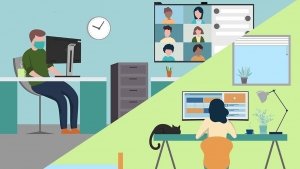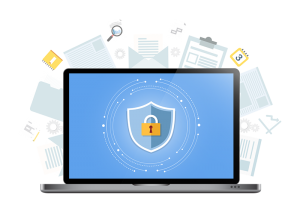Hybrid Business Strategy: Examples, Considerations, and Recommendations

The Business Side of Hybrid Workplace Strategy
The business side of hybrid workplace strategy is forefront as we make plans for the future. In a survey recently published by Gartner, CEOs were asked to identify the top enduring changes resulting from the pandemic. 45% of CEOs stated that hybrid and remote work was the most significant long-term impact. This equals all other noted enduring changes, combined. Nearly every business will have some degree of remote and hybrid working arrangements, as we experience a change in employee expectations and broader cultural shifts.
In past posts, we have looked at the technology and related managed cloud services needed to properly support remote and hybrid workplaces. The business administration issues related to hybrid and remote work are more complex than the technology solutions.
Four Hybrid Workplace Business Considerations
We’ve broken down what you should think about when it comes to hybrid workplace strategy into four key points. Each of these aspects of a hybrid workplace contains examples of how a hybrid business strategy might be implemented. See how these four considerations can help you strike the right balance and create a hybrid workplace that prioritizes people.
1. Working Environment
As we have noted before, as employers we are responsible for providing staff with a safe and healthy work environment. If employees are working remotely, or from home, on a regular basis (an expectation for the job), their work environment must be managed appropriately through a hybrid work strategy. We are responsible to ensure appropriate lighting, noise, desk space, seating, and ergonomic accommodations, as well as productivity tools, and cloud collaboration services.
2. Payroll, Benefits, and Compliance
With employees working at home, you are more likely to be paying employees who both live and work out of state (or in another tax jurisdiction). In addition to accurately representing their work location for payroll, you will need to provide benefits in each state and comply with each state’s employment laws. Minimum wage, sick time, and paid leave are a few of the regulations that differ between states, and need to be considered in a hybrid business strategy. Healthcare plans and providers will also differ, as do contributions to state unemployment insurance programs. Additionally, you will need workers’ compensation insurance coverage for each state in which employees work.
3. Insurance
Beyond workers’ compensation, you may need to update your general liability coverages to address employees working from home. Your insurer may see additional risk and/or the need to document work locations to ensure your business is properly covered. Most policies require that you list any company-owned or leased work spaces, including co-working spaces.
4. Taxes
Lastly, when it comes to a hybrid workplace strategy, having employees work in your state while living in another is not uncommon. States have reciprocity agreements that dictate how these employees need to file their personal tax returns. When you have remote employees working in other states, the rules are not yet as clear. Some states expect you to withhold taxes based on your employees’ locations, as this is their workplace.
Even more impactful, some states see an employee’s work location as creating nexus, and will require you to file business tax returns in that state.
Recommendations on a Hybrid Workplace Strategy
We strongly recommend that you proactively address the business side of hybrid work. Speak with your HR, tax, and legal advisors as you navigate and design your hybrid strategy and remote work plans.
- Consider using a Professional Employment Organization, or PEO, to manage payroll, benefits, HR policies, unemployment insurance, and workers’ compensation insurance. In addition to operating across state lines, PEOs provide you with a unified approach to human resource services. They can assist with recruiting, onboarding, offboarding, and regulatory needs such as driver safety, OSHA compliance, and testing for banned substances. PEOs als0 assume liability for compliance errors.
- Be prepared to provide employees working from home with the workspace and accommodations they need to be healthy, safe, and productive. Beyond IT, we can assist with home office workstations, desks, stands, lighting, and more.
- Communicate with your insurance provider to ensure your coverages are appropriate and correct.
- Consult your tax and legal advisors to ensure you understand when, and where, you have nexus with respect to corporate registrations and taxes.
If you’d like to chat more about hybrid business strategy, be sure to get in touch!

 The Kaseya attack demonstrates how cyber crime is a big, organized business. How big? You can subscribe to “Ransomware as a Service” and outsource attacks on your intended targets. How organized? Hacker groups and service providers, such as the REvil Ransomware Group and DarkSide, actively manage their brands and reputations. The REvil attack on Kaseya shows us that cyber criminals are technically advanced and operationally sophisticated. The nature of the attack, and its scope, should scare you.
The Kaseya attack demonstrates how cyber crime is a big, organized business. How big? You can subscribe to “Ransomware as a Service” and outsource attacks on your intended targets. How organized? Hacker groups and service providers, such as the REvil Ransomware Group and DarkSide, actively manage their brands and reputations. The REvil attack on Kaseya shows us that cyber criminals are technically advanced and operationally sophisticated. The nature of the attack, and its scope, should scare you.